La Nina has defied its breakdown in the tropical Pacific Ocean. Cold anomalies are for now stable, extending their weather influence into the Summer season. Changing patterns in the tropics are also hinting at a possible La Nina influence for the cold season of 2022/2023.
But what are these oceanic events, and how can they change the seasonal weather across the entire world? As you will find out, they are actually both just a part of a large old system that connects the ocean and the atmosphere called ENSO.
We look at the latest changing conditions across these ocean regions, and what the latest forecast shows for the coming months. You will see just how strong of an influence these oceanic anomalies can exert on the weather patterns, changing the course of weather on a global scale.

ENSO GLOBAL WEATHER IMPORTANCE
ENSO is short for “El Niño Southern Oscillation”. This is a region of the equatorial Pacific ocean, that changes between warm and cold phases. Typically there is a phase change around every 1-3 years.
ENSO has a major influence on the tropical rainfall patterns (storms) and the complex exchange between the ocean and the atmosphere. We can observe large-scale pressure changes in the tropics with each new developing phase. After some delay, these changes affect the circulation over the rest of the world.
The image below shows the ENSO regions in the tropical Pacific. Regions 3 and 4 cover the east and west and together cover a large part of the tropical Pacific. The main area is a combination of regions 3 and 4, seen in the image as the Nino 3.4 region.

Each ENSO phase has a different effect on the pressure and weather in the tropics. This has an effect on the overall global circulation with time, changing the weather patterns worldwide differently.
Each phase (cold/warm) usually starts to develop between late summer and early fall and typically lasts until next summer. But some events can last even up to two years.
The cold ENSO phase is called La Nina and the warm phase is called El Nino. Besides the temperatures, one of the main differences between the phases is also in the pressure patterns they are associated with.
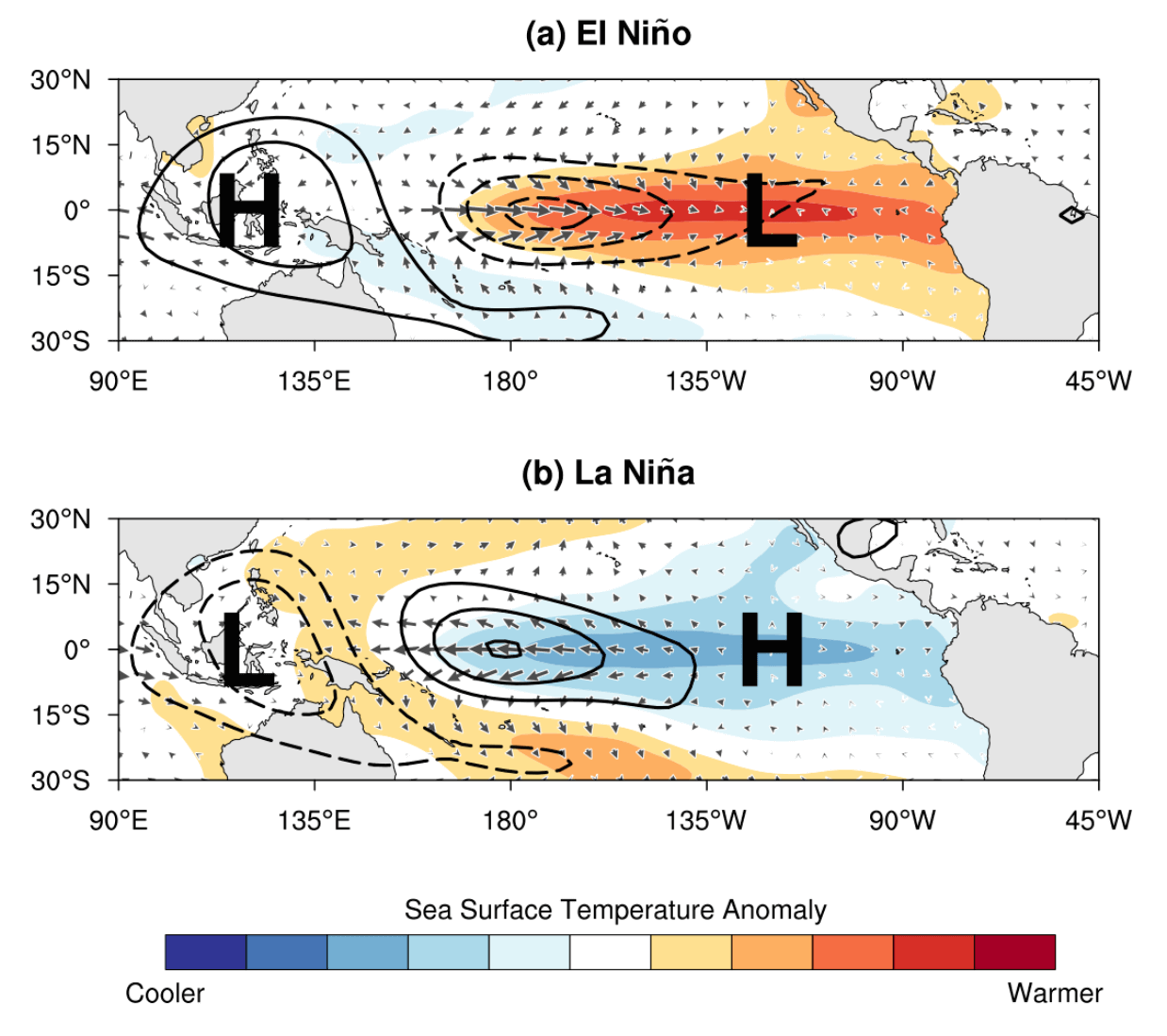
During an El Nino, the pressure over the tropical Pacific is lower, with more rainfall and storms in this region.
But during a La Nina, the pressure over the equatorial Pacific is high, creating stable conditions and less convection. These pressure changes translate into the global circulation, affecting both Hemispheres with time.
Typically, an El Nino develops stronger anomalies, which are focused more on the central and eastern regions. But while La Nina usually has weaker anomalies, they typically peak more from the central to the western region.
The image below from NOAA Climate shows the typical circulation during a cold ENSO phase (La Nina). Air descends in the eastern Pacific, causing stable and dry weather. At the same time, the air is rising in the western Pacific, causing frequent thunderstorms, low pressure, and a lot of rainfall.

This way, ENSO can have a major impact on the tropical rainfall and pressure patterns and thus impacts the ocean-atmosphere feedback system. Through this ocean-atmosphere system, the ENSO influence is distributed globally.
We usually observe a global shift in pressure patterns during the emergence of an ENSO phase but it is more influential during the peak of its phase.
But why does ENSO shift between cold and warm phases? There is no simple answer, but we can say that it is a result of the complex relationship between pressure patterns and winds.
The tropical trade winds usually start or stop a certain phase, by mixing the ocean surface layers and altering the ocean currents and temperature.
What are the trade winds? The trade winds are steady, and persistent winds, blowing towards (and along) the Equator in both Hemispheres. The image below from Weather.gov nicely shows a simplified map of the global prevailing winds, with tropical trade winds in yellow and red.

We produced a map that shows the prevailing near-surface winds, based on the actual data in the past 4 decades. We can see the easterly trade winds in the Atlantic Ocean and in the Pacific Ocean, which help to drive the ENSO region’s warming and cooling.
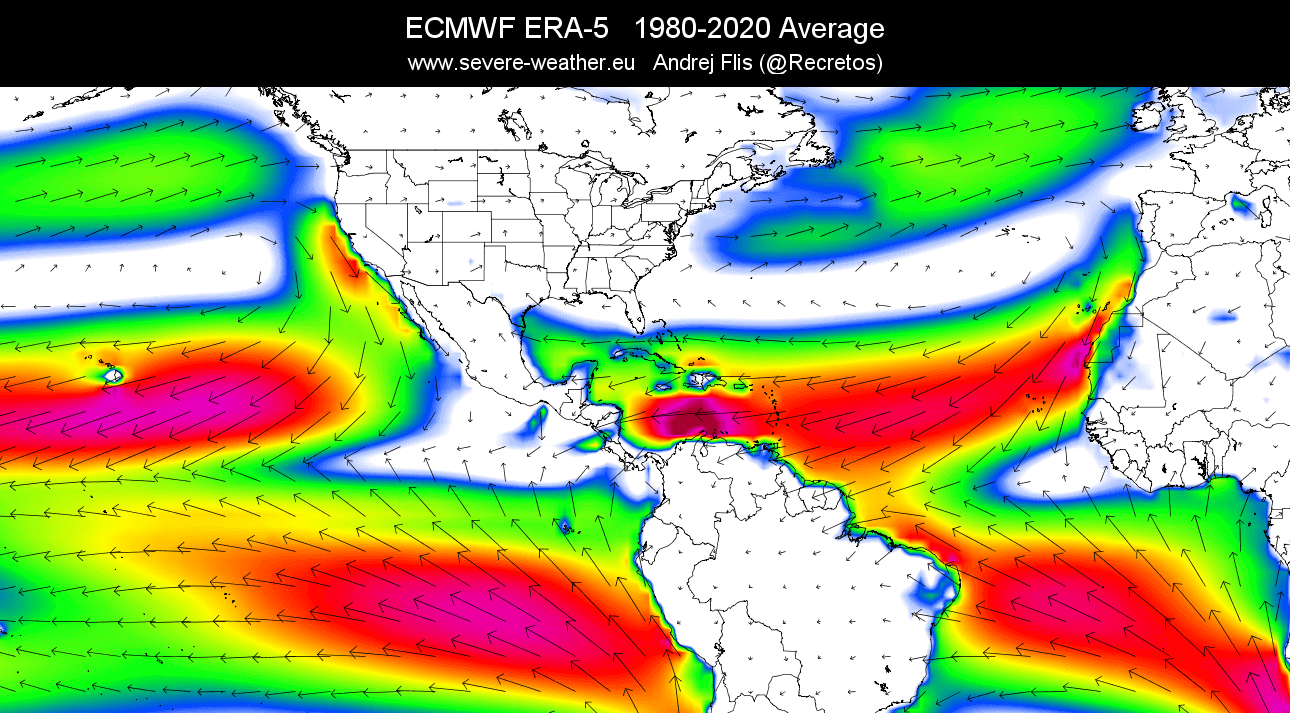
When these easterly winds get stronger, they tend to change the ocean surface currents, and they start pushing the water from east to the west. This pushes warmer surface waters towards the west but brings deeper (colder) waters up to the surface to replace them.
This process is much better seen in the video animation below, which shows the ocean temperature anomalies from Summer to late Fall 2021.
You can see ENSO cooling starting in July, as the cold waves develop across the equatorial Pacific. They are formed as the surface water is being pushed west by the trade winds, now replaced by deeper colder water.
The image below shows the latest trade wind anomalies in the tropical regions. We can clearly see stronger than normal easterly trade winds (negative). Strong trade winds prevail in the tropical Pacific, across the westerly/central ENSO regions.
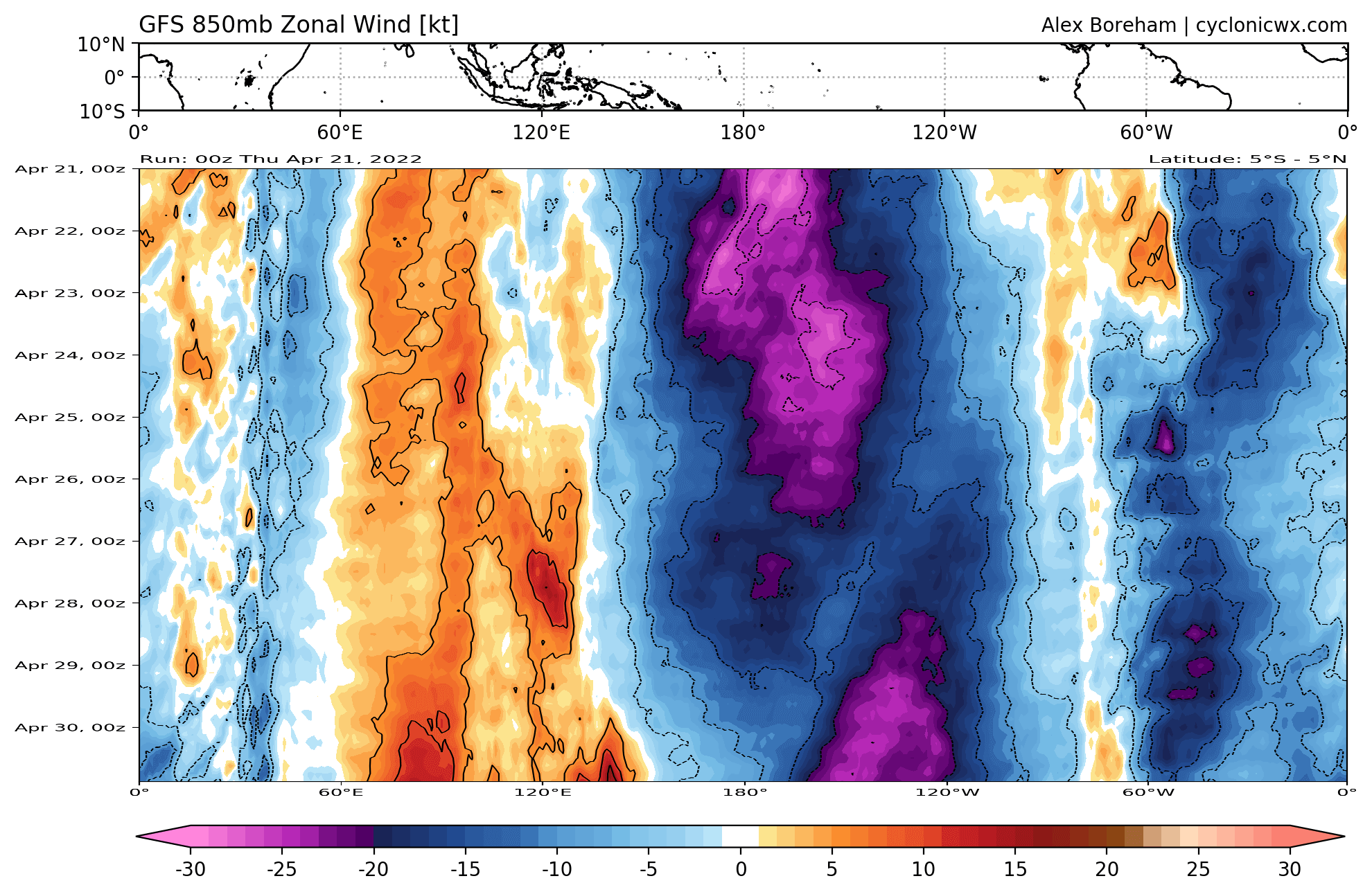
But the key is not just in the winds themselves, as they are typically being driven by pressure changes. The ENSO phase directly responds to an atmospheric pressure change, called the Southern Oscillation Index.
The Southern Oscillation Index or SOI represents the difference in air pressure measured at Tahiti (French Polynesia) and Darwin (Australia). The image below shows the location of the two pressure zones that are important for ENSO.

Positive SOI values mean that the pressure over the Tahiti side is higher than over Darwin in Australia. This corresponds to stronger easterly trade winds, supporting La Nina conditions.
But during an El Nino, we see lower pressure in the eastern Pacific and over Tahiti, and higher over Darwin, Australia. This produces a negative SOI value and weaker trade winds, which means less ocean cooling.
On the SOI analysis below, we can see persistent positive values. This further supports stronger trade winds and the ocean cooling in the ENSO regions, sustaining and extending the La Nina towards Summer.

LA NINA TO STAY – LATEST DATA
Current global ocean analysis reveals the continuing presence of cold ocean anomalies in the tropical Pacific. This is across the ENSO regions, seen earlier above. The sustained trade winds, and a lack of a westerly wind burst, have enabled the La Nina to survive, and extend deeper into 2022.

Focusing on region 3.4, you can see the first La Nina from the 20/21 season in the image below. New ocean cooling began in late Summer and Fall last year. That was the development of the current cold phase. Peak cooling was weaker than the first La Nina, as the second-year event is usually weaker than the first event.

A change in the tropical trade winds in January has ended the cooling process, effectively starting the breakdown of the La Nina event.
You can see this process on the graph below, which shows the temperature anomalies in the ENSO 3 region. Warming was ongoing since late January. But strengthening trade winds and a lack of westerlies has now pushed for a new cooling since late March.
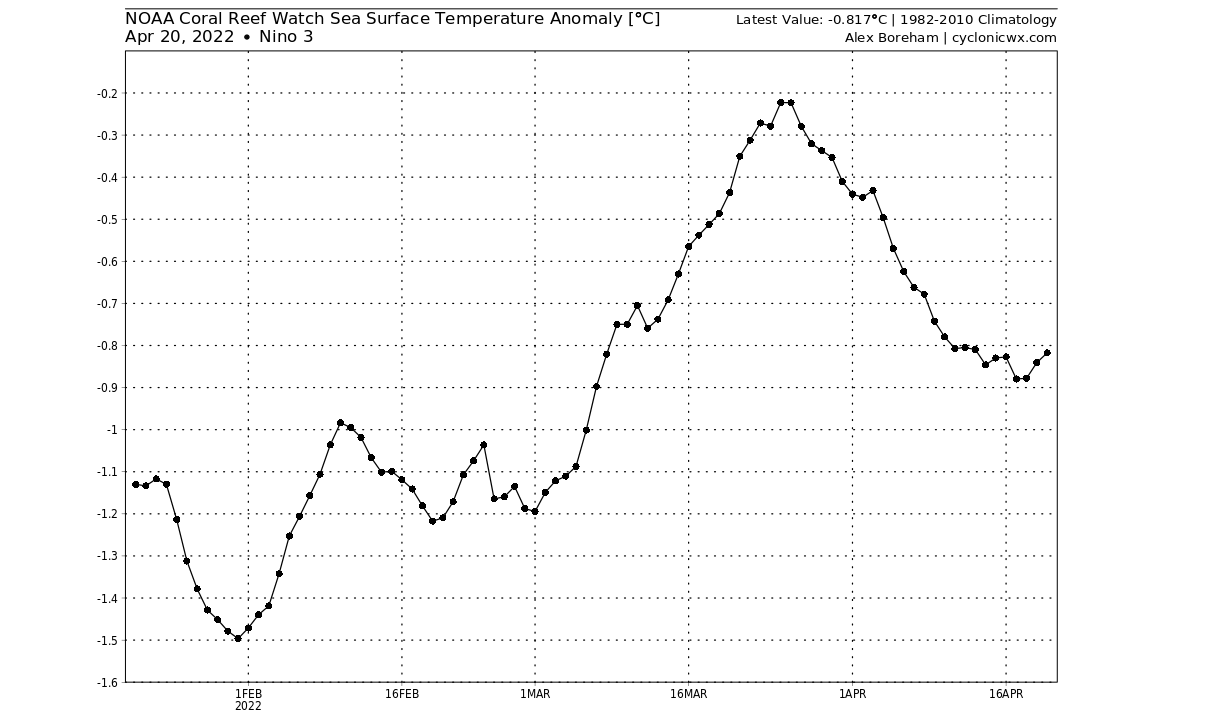
We have the ocean analysis from early February below. Cold anomalies were much stronger in the eastern tropical Pacific region. But in the central and western ENSO regions, the cold anomalies were breaking down.

But looking now at the latest anomaly analysis of the ENSO regions, you can nicely see the cold anomalies returning in the central and western tropical Pacific. Peak cold anomalies are now focused more on the eastern regions, where the trade winds have re-intensified, creating a stronger upwelling effect.

Below we have a 15-day ocean temperature anomaly change. We can see the cooling effect in the easterly ENSO regions. Also in the central area, we have more cooling than warming ongoing. This was certainly unexpected, given the forecasts just a few weeks-months ago.
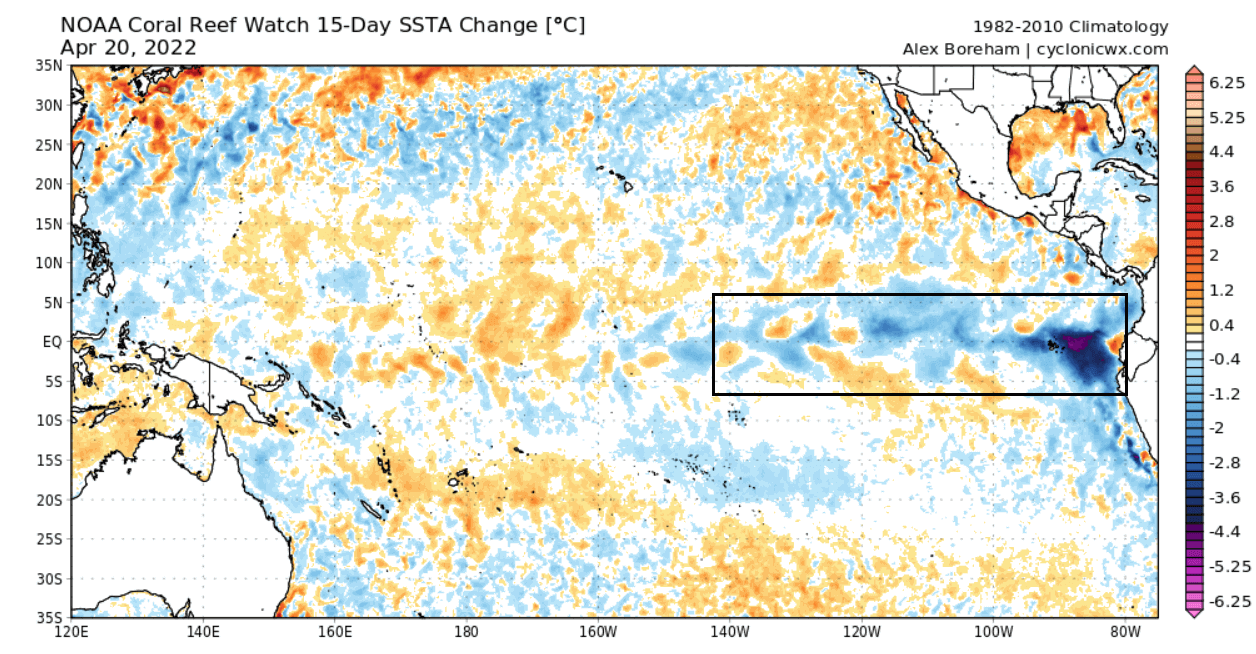
But perhaps a stronger (invisible) process is developing below the ocean surface. In the image below you can see the early February temperature anomalies by depth across the tropical Pacific Ocean. There was a warm Kelvin Wave spreading below the ocean surface, eradicating the La Nina.

The Kelvin Wave was present at around 80-200m depth. It was pushed in by the westerly currents. It caused the weakening and breakdown of cold anomalies in the central and western ENSO regions.
But looking now at the latest high-resolution depth analysis under the ENSO regions, we see colder than normal temperatures below the surface returning. This was enabled by the weakening of the westerly currents, and the strengthening of the easterly Trade Winds.
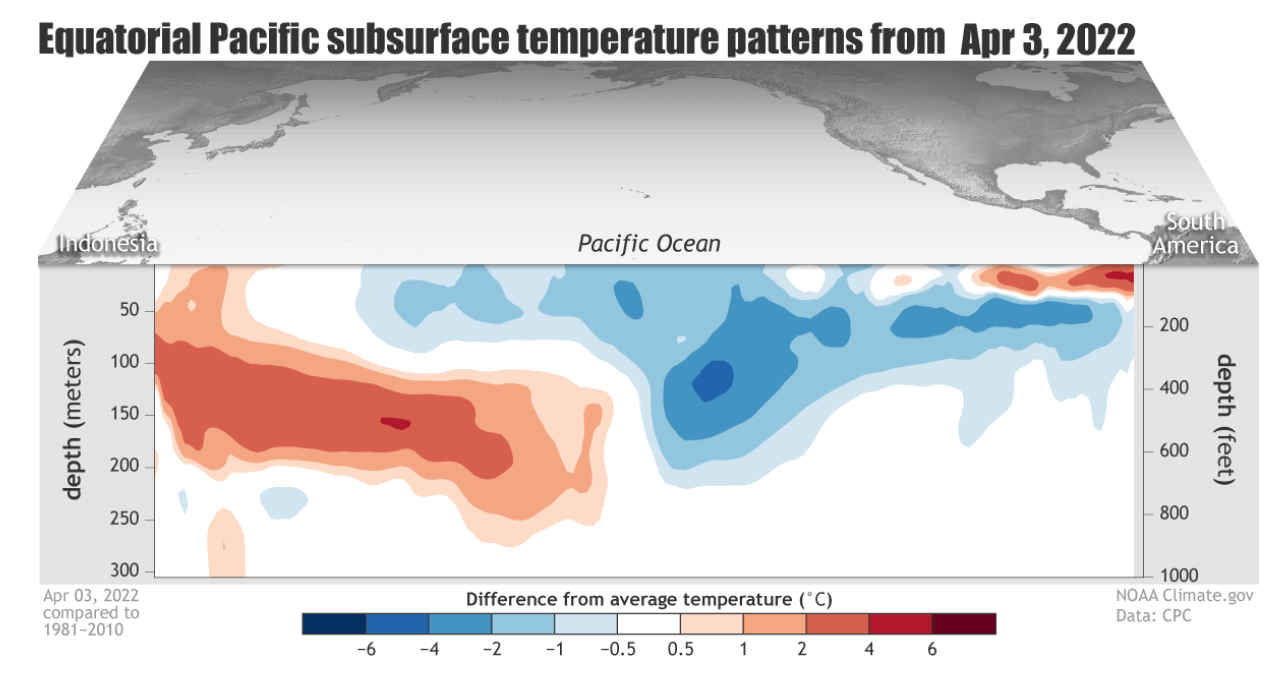
One way to look at the whole ENSO region temperature strength is by looking at the ocean heat content. This also takes the water temperatures at depth into consideration, not just at the surface.
And below we can see the cold anomalies developing in late Summer, and peaking in mid-October. The subsurface cold anomalies have weakened intermittently, with the Kelvin Wave below the surface. But a new cold wave is taking over, as seen in the images of depth above.
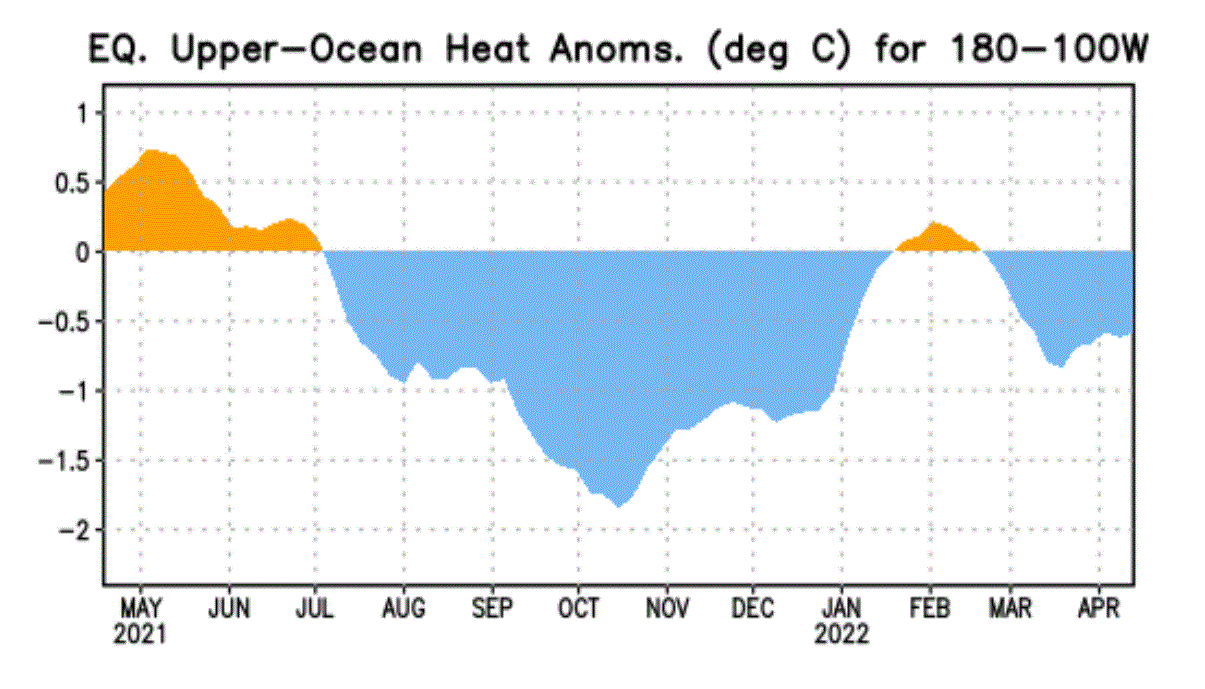
We can see the whole process better in the next image below. It shows the upper ocean heat anomalies across the tropical Pacific regions. We can see the colling starting in late last Summer, lasting into mid-winter.
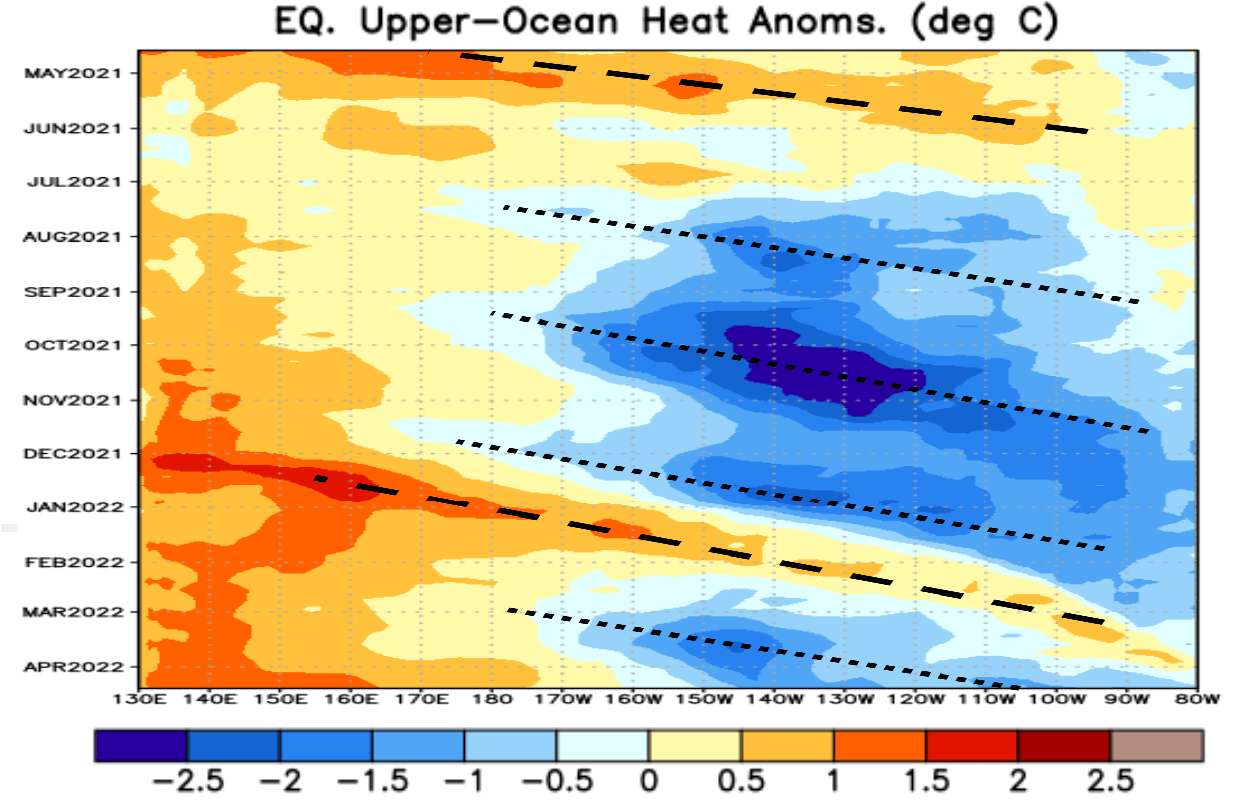
In January, we can see the warm Kelvin Wave pushing in. But it is now being replaced by a new cold wave emerging below the surface, driven by trade winds and the process of upwelling.
We know the current state of La Nina and how it got to this point. So it’s time we look at how it is expected to evolve further into the year, and how it will impact our seasonal weather.
ENSO LONG-RANGE FORECAST
You now know what ENSO is and what its phases are. So we are going to focus on its evolution through the current season and see what the most recent forecasts show further into 2022.
Below we have the ocean temperature forecast for Summer 2022, from the ECMWF. It now shows a continuing cold anomaly across the equatorial Pacific Ocean. Some cold anomalies can be seen south of the equator and towards the west, but keeping this an overall compact cold event.
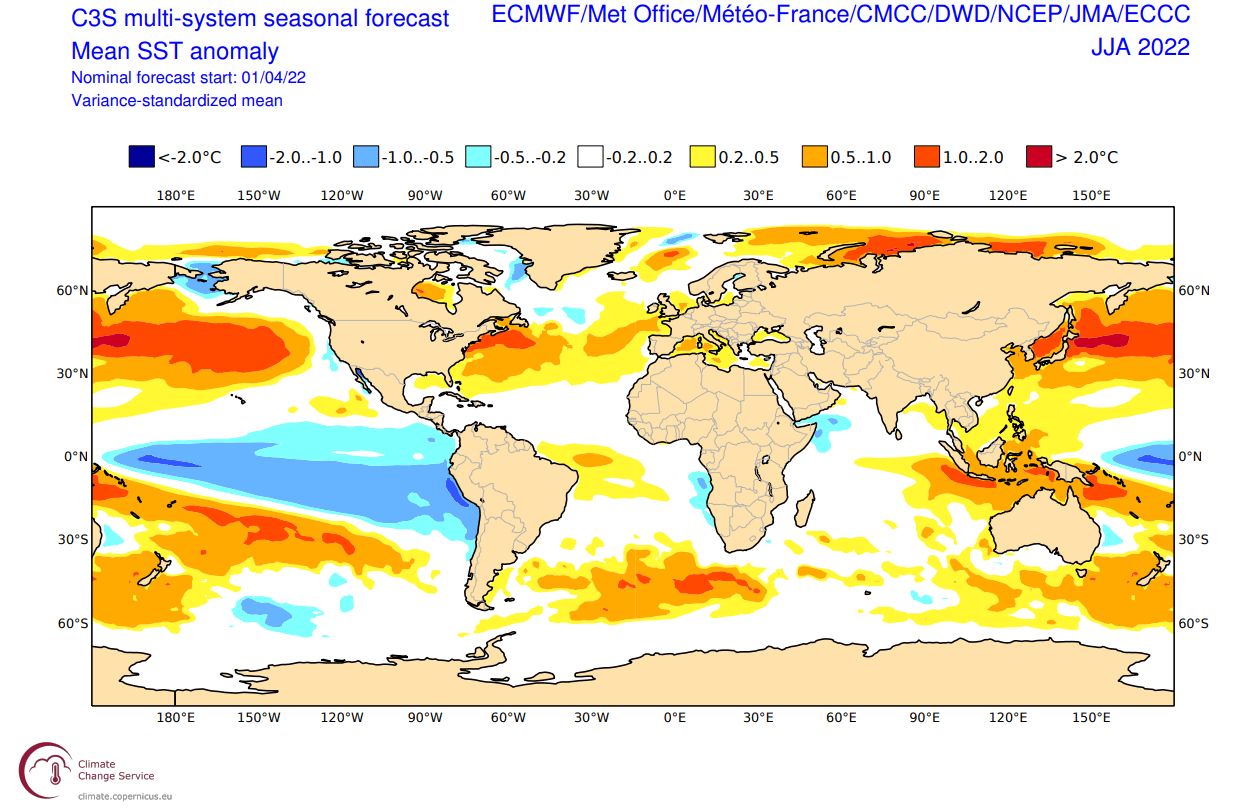
The ENSO analysis and ensemble forecast below from ECMWF shows that La Nina developed last Fall, and keeps going. The forecast does show a sustained cold phase into the Summer. There is less certainty going into Fall, but more members go for the negative phase.
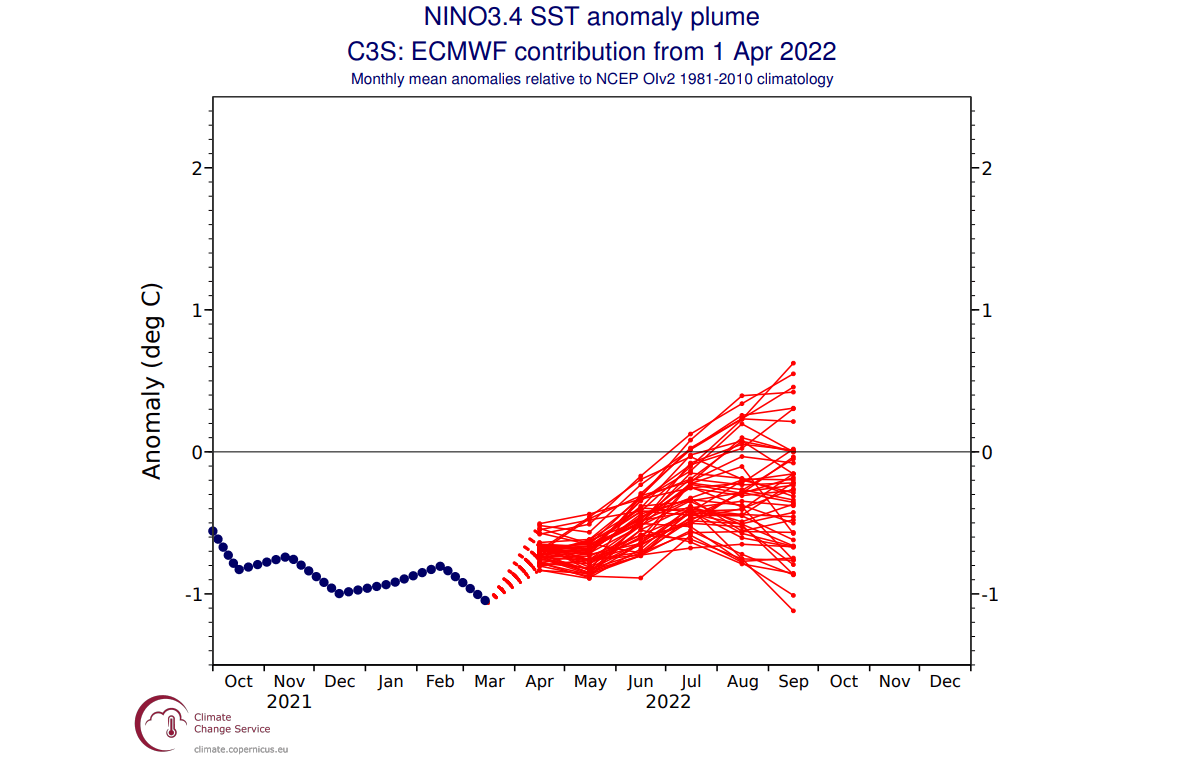
The ENSO forecast from the United States CFSv2 is similar. It shows the current cooling to simply continue deep into 2022. It sustains the cold anomalies over Summer, and into the 2022/2023 cold season. We have to add that this model was the first one to hint at a possible 3-year cold event.

The CPC/IRI official probabilistic ENSO forecast shows the current La Nina lasting over the summer and into the early cold season of 2022. It is typical for a new phase to emerge in late summer/fall with seasonal pressure changes. But for now, it appears that the La Nina is likely to continue into next Winter.
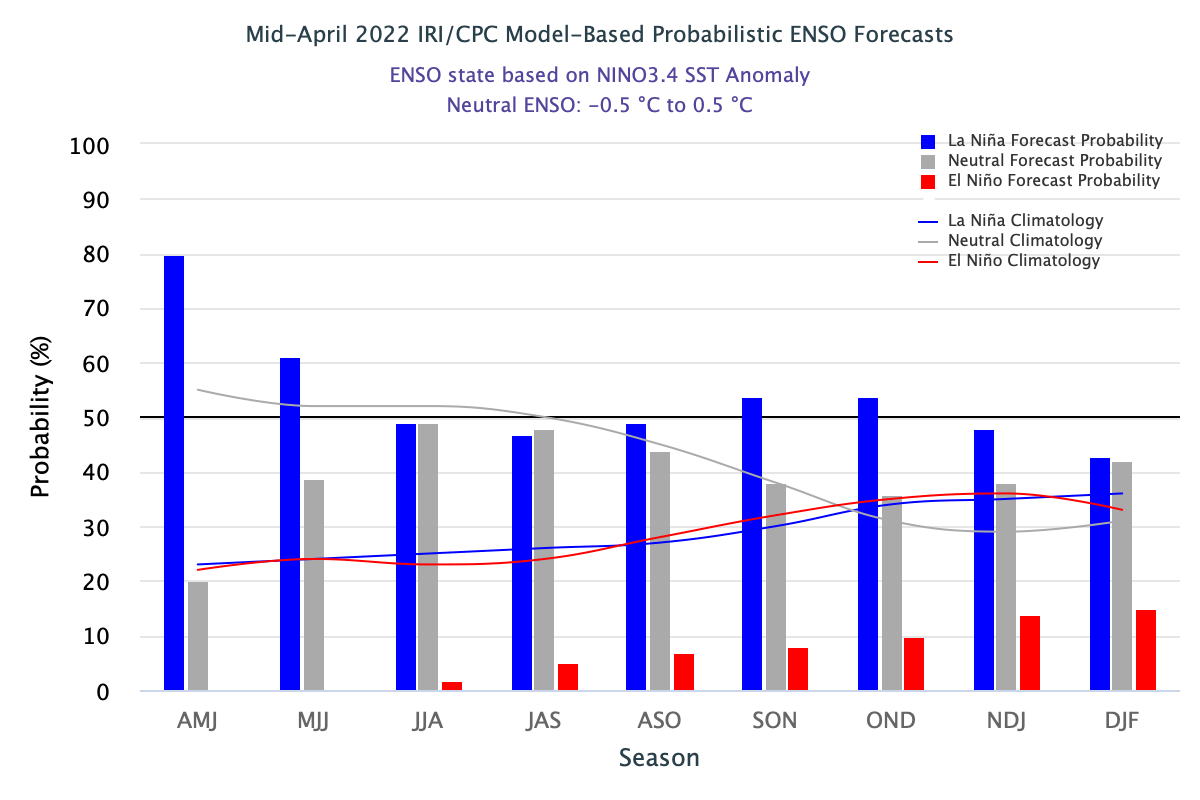
Below we have an analysis and forecast image from multiple North American seasonal models. It also shows the La Nina pretty much sustaining into the summer season. Going deeper into the year, we see the 3rd year La Nina event developing in Fall and for Winter 2022/2023.

Trends are currently in favor of a cold phase (La Nina) sustaining or re-strengthening in the second half of 2022. This would again create a special set of weather patterns in the Fall and the next Winter season 2022/2023.
But how does the La Nina event impact the seasonal weather, and what can we expect this year in the warm season?
LA NINA WEATHER SEASONS
Based on all the available data, an official La Nina advisory is in effect, as explained in the statement by the NOAA’s Climate Prediction Center:
“La Niña is favored to continue through the Northern Hemisphere summer (59% chance during June-August 2022), with a 50-55% chance through the Fall. This month, the forecaster consensus predicts Niño-3.4 index values to weaken into the summer but remain below the threshold of La Niña.”
Below we have an image that shows the average winter pressure pattern from multiple La Nina winters. The main feature is a strong high-pressure system in the North Pacific and low pressure over Canada.

Looking closer at the La Nina cold season weather signature below, we can see its main feature, a persistent high-pressure system in the North Pacific. That usually shifts the jet stream from the northwestern United States down into the east, creating a “colder north/warmer south” weather pattern over the United States.

Alaska, western Canada, and the northern United States typically get a colder than normal winter, with more precipitation. Southwestern and the southern United States usually experience warmer and a bit drier conditions during a La Nina winter season.
But what can we expect from the La Nina influence during the warm season?
In the image below we have the correlation between the cold ENSO phase and the summer jet stream. We can see a stronger jet stream over the northwestern United States, and a weaker subtropical jet stream over the southern United States in a La Nina Summer.
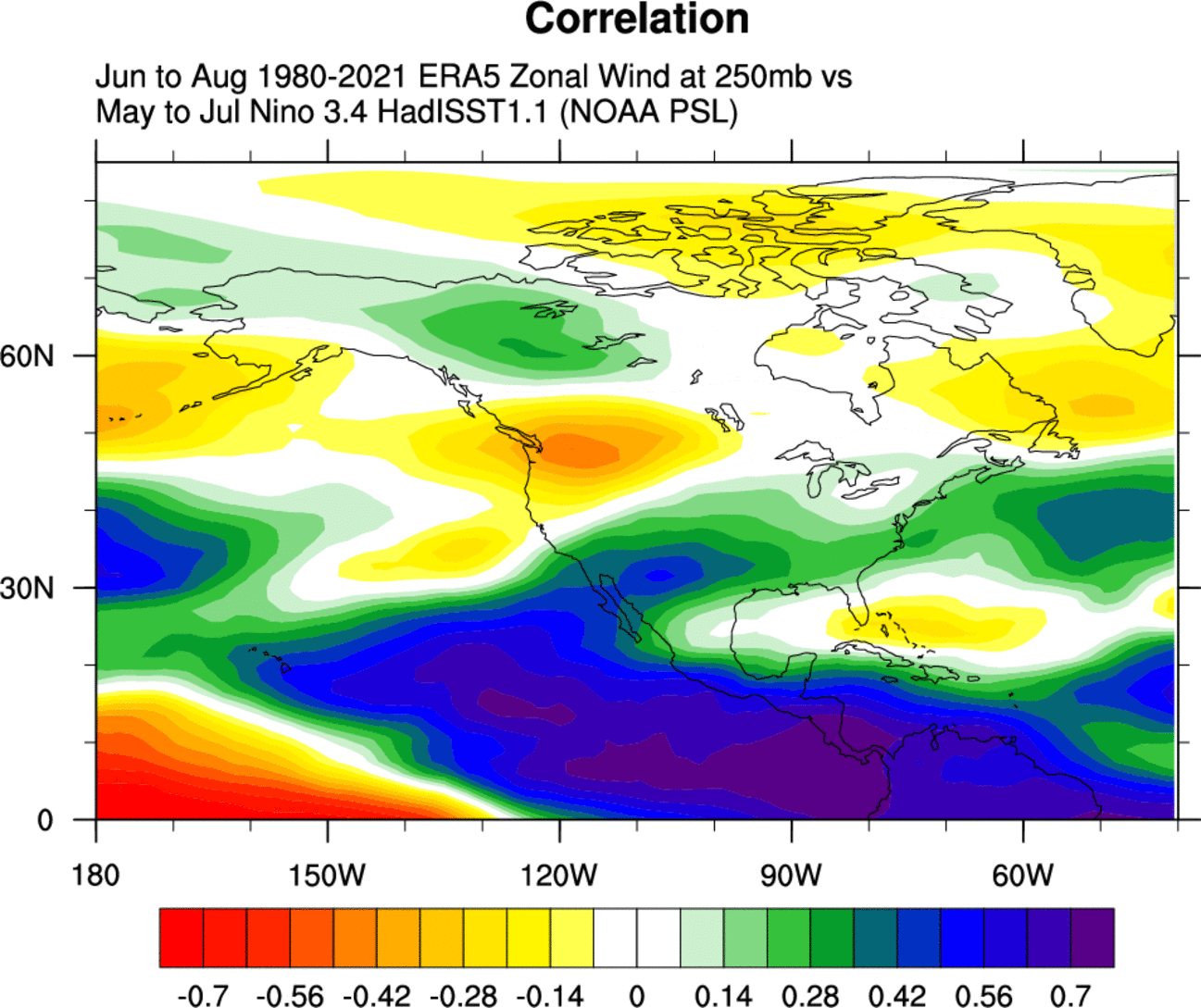
Historically, the most typical effect of a cold ENSO phase is a blocking high-pressure system in the North Pacific. We can see below, that the North Pacific high-pressure tendency during a La Nina also exists during Summer. The high-pressure pattern extends from the North Pacific into the west/central United States.
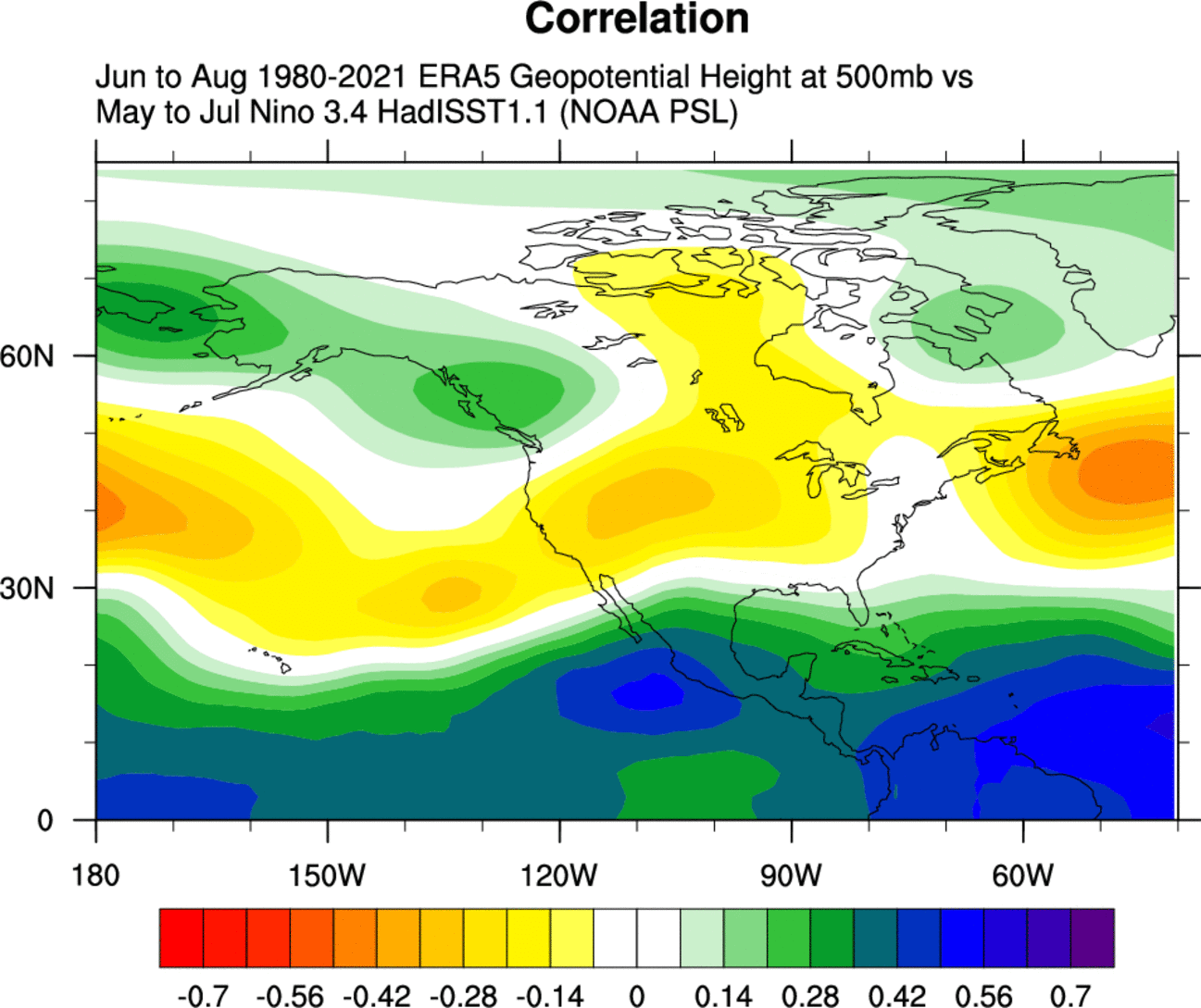
But we can also see a stronger high-pressure signal over the northeastern United States, centering to the east into the North Atlantic.
We are focusing on the Pacific/North American region in this segment because the warm season La Nina influence is most profound here. Unlike in the cold season, there is much less (or none) of an actual direct weather pattern effect on the European sector.
Below we have a special graphic, that shows the Spring temperature impact of a La Nina phase for the United States. We can see that the cold north/warm south pattern extends into the Spring season.
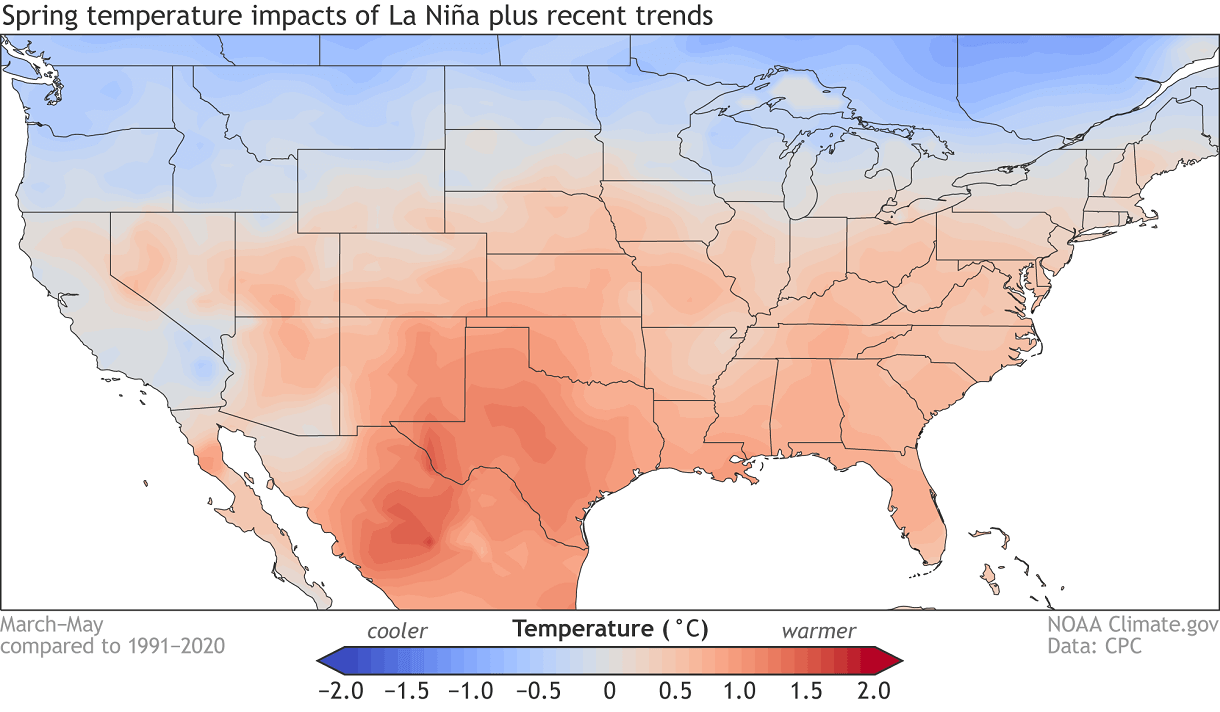
The spring precipitation pattern for a cold ENSO event is similar to the winter pattern. We have more precipitation north, northwest, and the parts of the eastern United States. Drier conditions prevail over much of the far south and the southwestern United States.
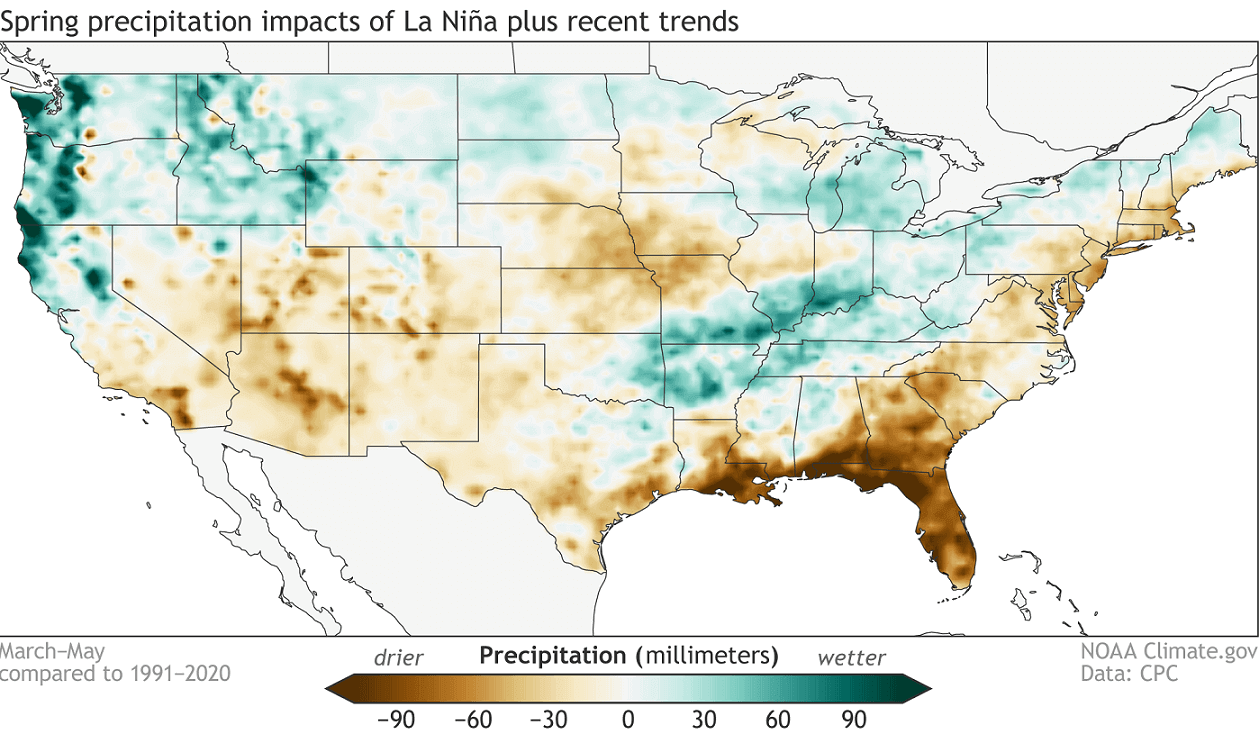
Below we have the Summer temperature and precipitation anomalies for the United States in Summers following a Spring La Nina.
We can see warmer than normal temperatures over much of the western half of the country. Of note is a colder than the normal signal for the southeastern United States.
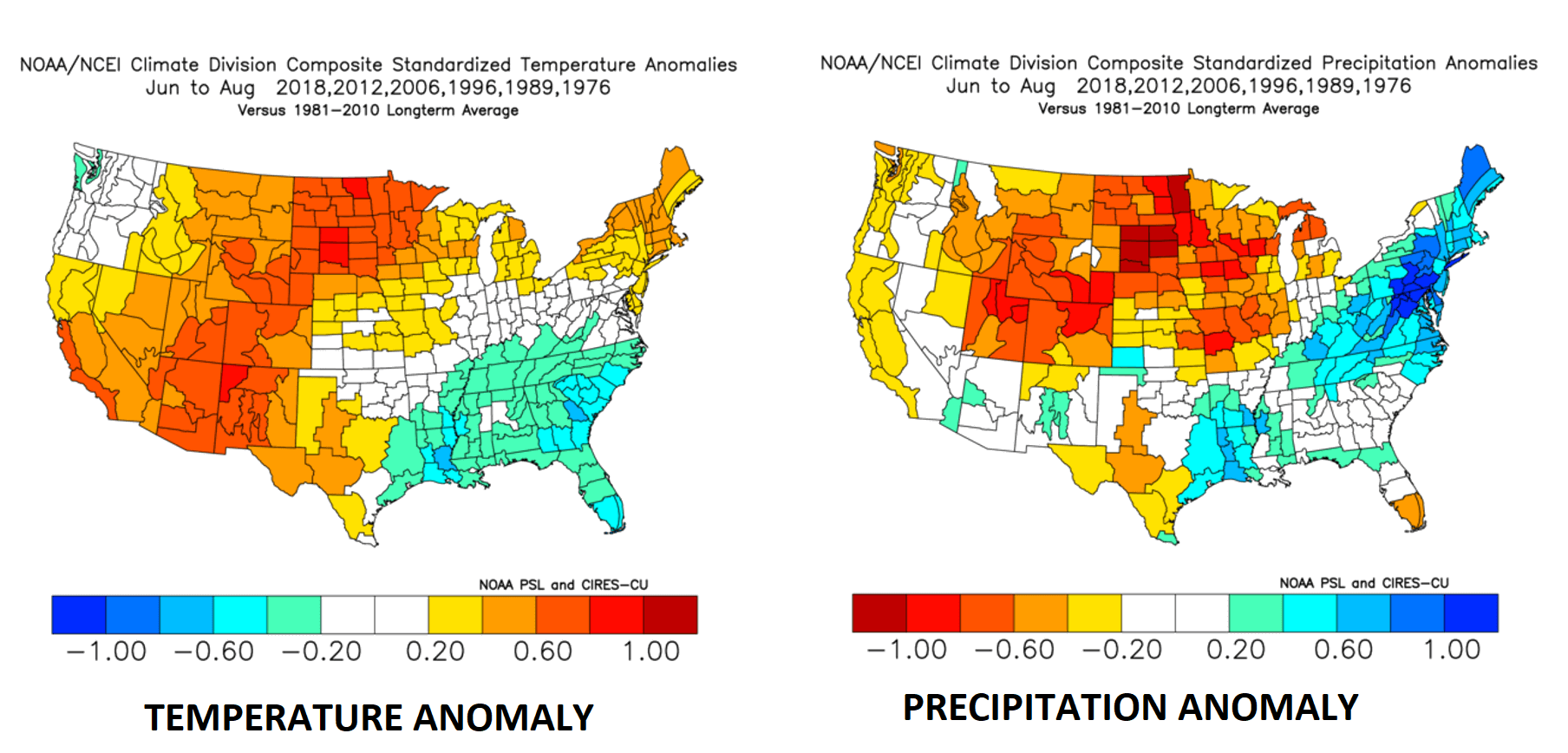
Precipitation-wise, we have a drier signal for a La Nina Summer over much of the north, central and western United States. More precipitation is hinted over the Ohio Valley and the northeastern United States, and also in the southeast.
These are patterns based on the historical data, from previous such events. But now we will look at the actual long-range forecast, and see what the model calculations show in terms of the La Nina influence.
LA NINA 2022 SEASONAL WEATHER INFLUENCE
We will look at the seasonal trends for Summer 2022, using the ECMWF forecast. The period in question is the meteorological summer season, covering the June-July-August period, and is the peak of the warm season.
We typically use the ECMWF first, as is often referred to as the most reliable model in the long-range category. In reality, a lot can change with the individual year/season. But generally, the ECMWF model is at the top as far as “skill” goes.
In the pressure pattern forecast from ECMWF below, we can see a La Nina high-pressure system remaining in the North Pacific. It extends over the western/northern United States.
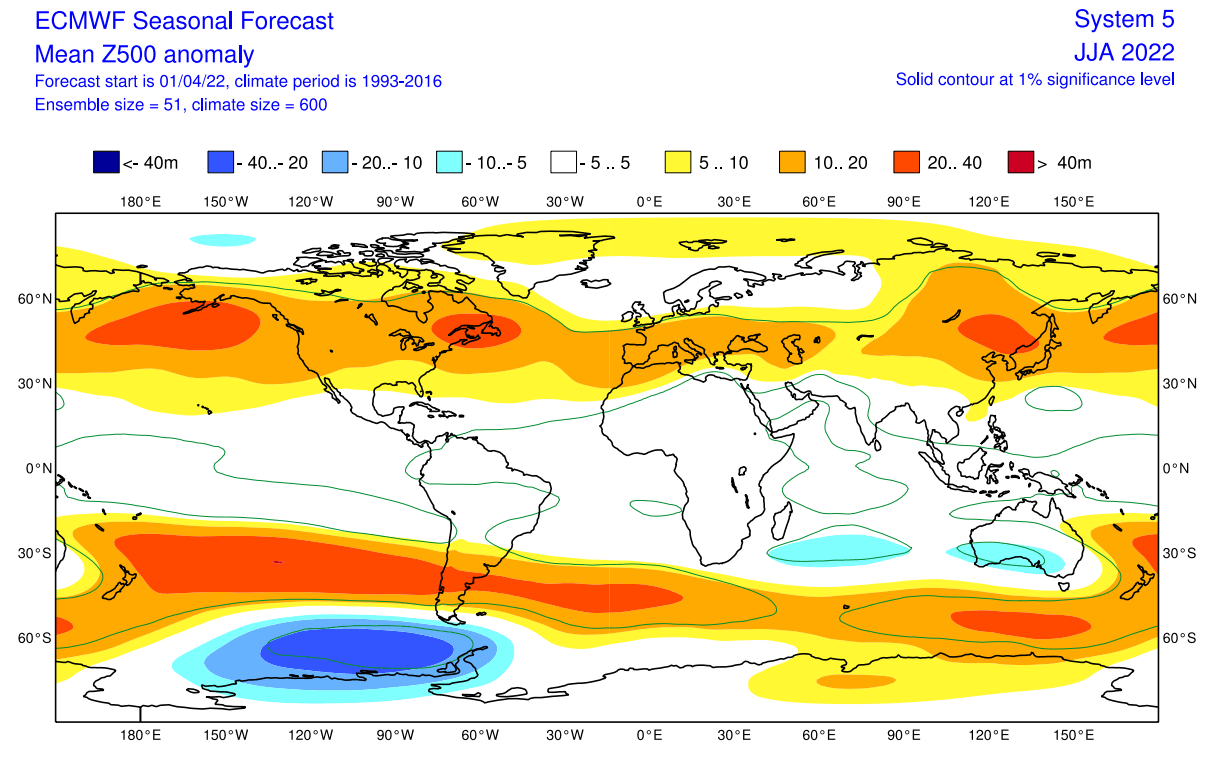
A stronger high-pressure area is found over the northeastern United States as we have seen in the La Nina signal graphic earlier above. This will have a regional effect on the weather development in the eastern United States and eastern Canada.
Another high-pressure system is over western Europe, with a low-pressure area contrasting over northern Europe.
The global temperature distribution also shows the La Nina pattern. Over North America, we see warm pooling over the central and northern United States. That is the warmer airmass under the high-pressure anomaly. Warm anomalies also extend over much of southern and eastern Canada.
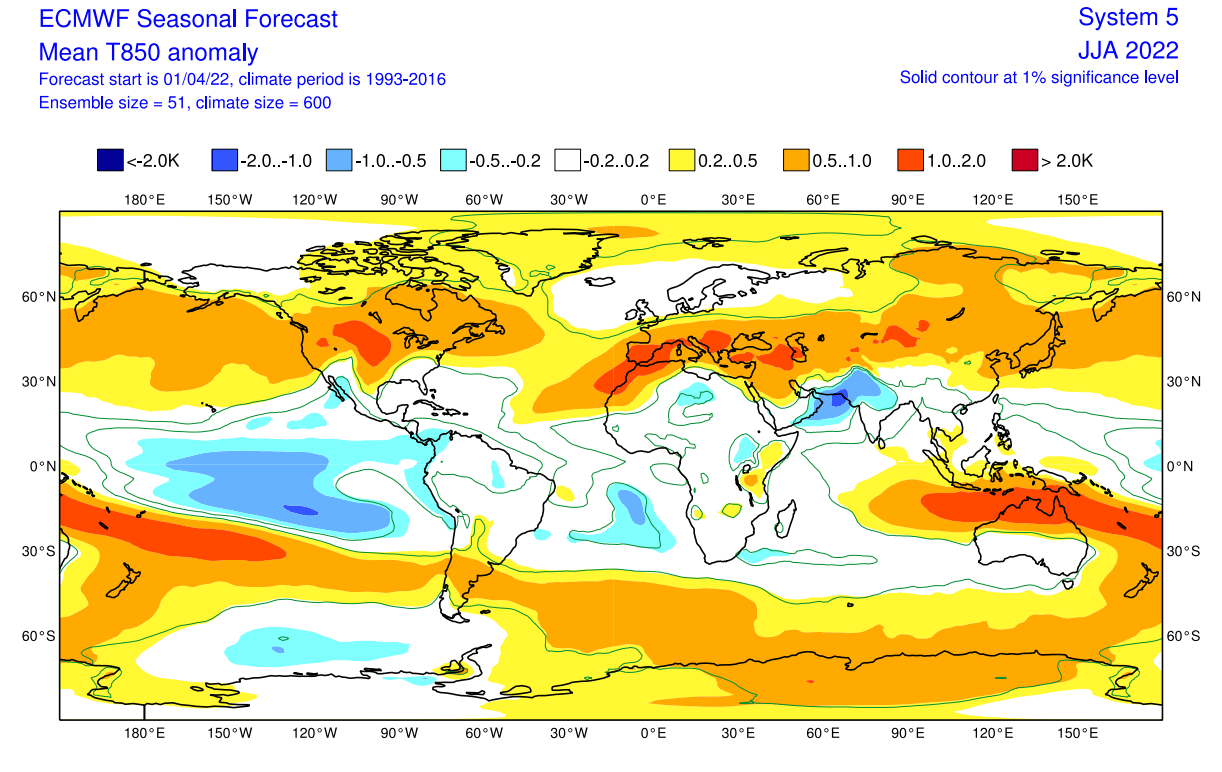
Europe features mostly warmer than normal conditions over the entire south-central half. Northern Europe however is seen neutral, under a likely cooler low-pressure area.
Looking closer at Europe, we see much warmer than normal weather over most of the continent. But the exception is northern Europe, which will be under the influence of a low-pressure system.
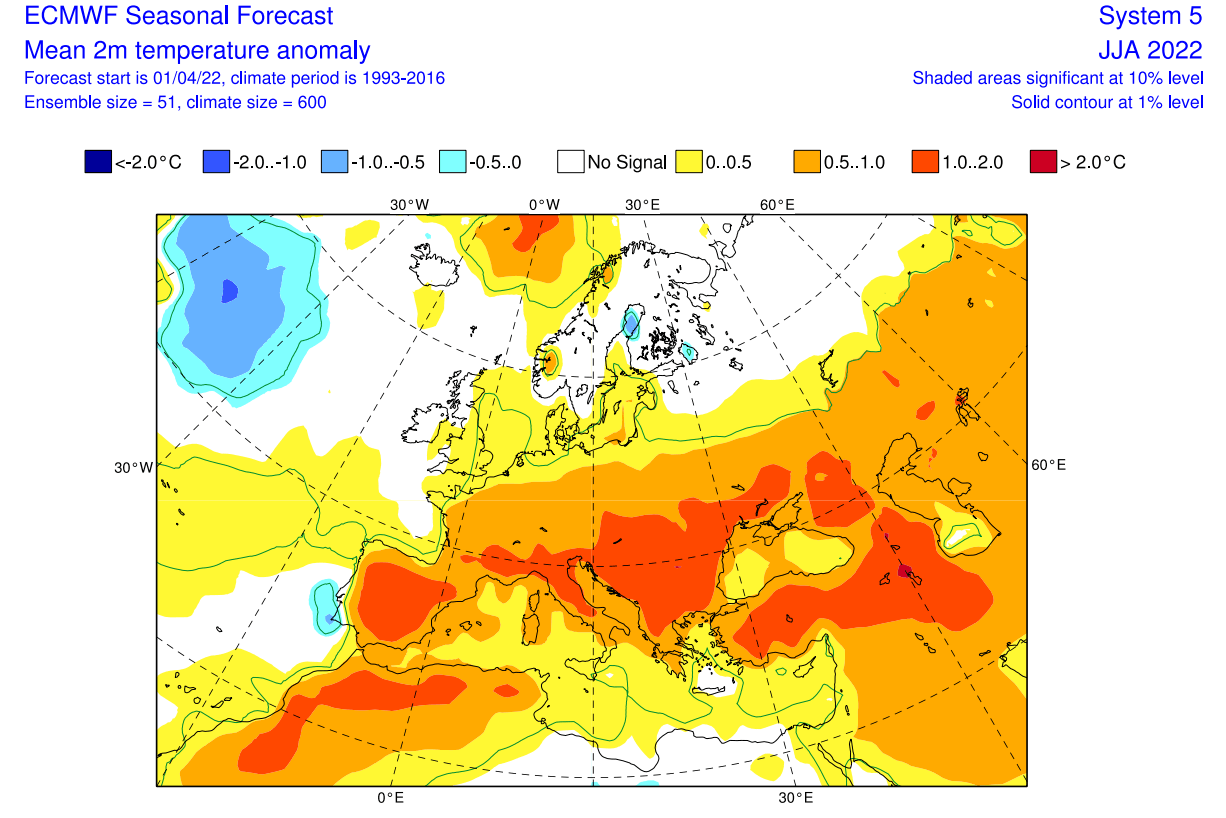
Over North America, we can now better see the warm anomalies over much of the central and western United States. The southeastern United States however does feature a neutral area, similar to the historical La Nina summer pattern we have seen earlier above.
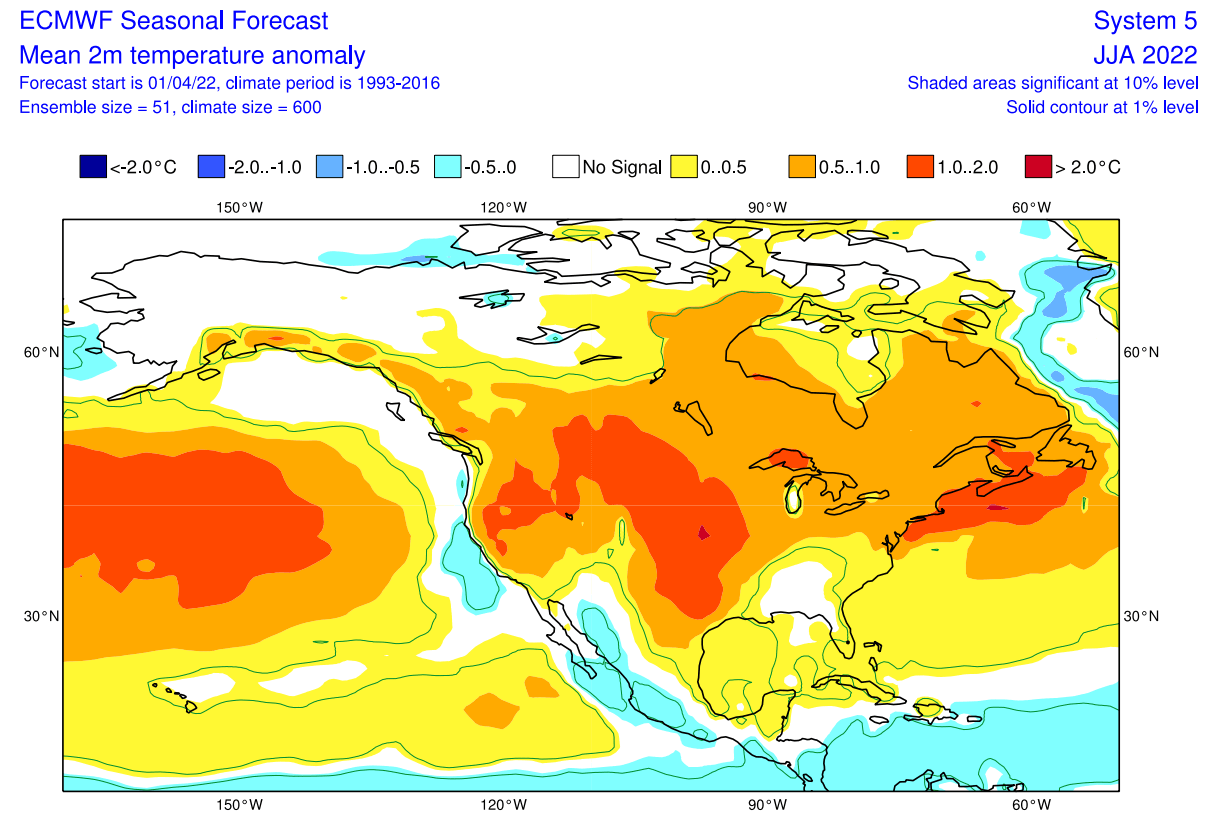
Warm anomalies are also forecast over much of central and eastern Canada, and also the northeastern United States. That region is under the influence of the high-pressure system in the region.
Normal to wetter conditions will prevail over northern Europe under the low-pressure zone. But the rest of the continent is expected to be quite drier than normal, creating a likely drought scenario.

The precipitation forecast over North America shows drier conditions over most of the central and northern United States. But parts of the southeastern and southwestern United States, and eastern Canada have a higher chance of wetter conditions.
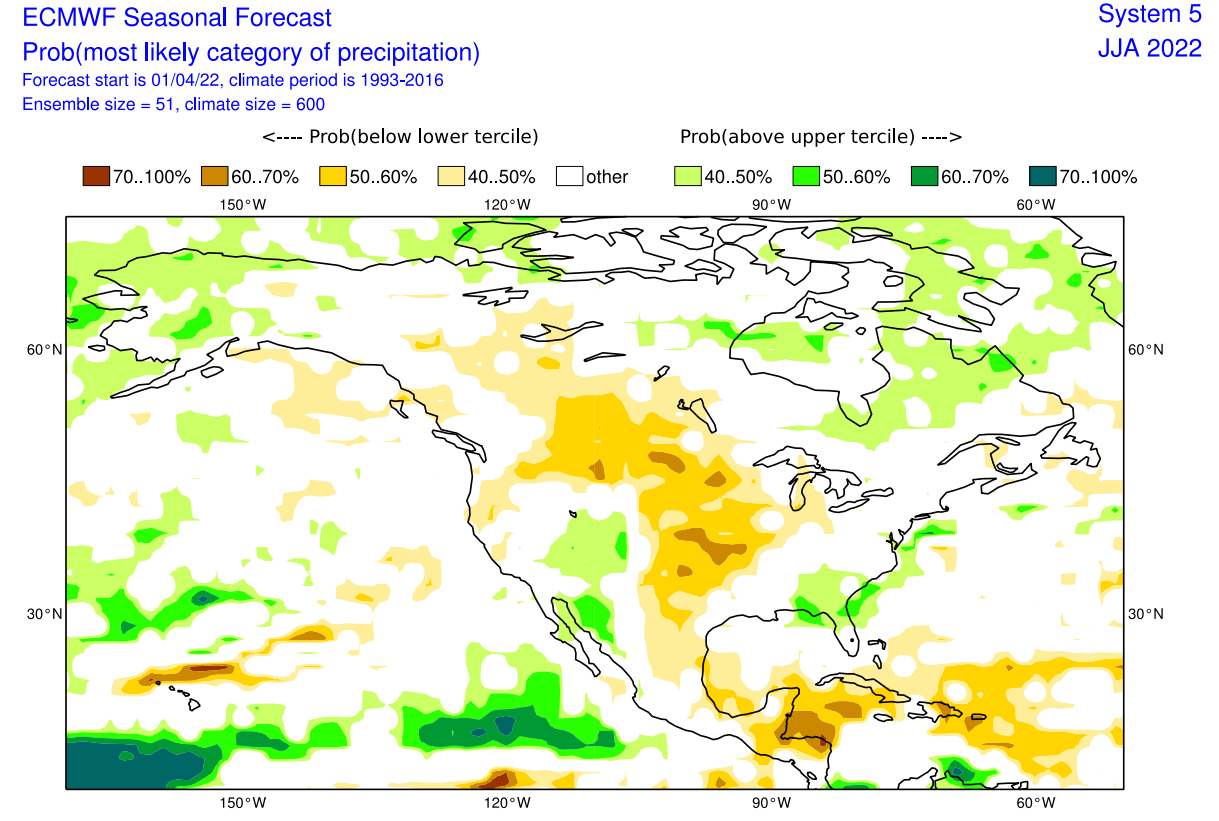
This is somewhat in line with the Summer La Nina influence that we have seen above, where the east and the southwestern United States can have more precipitation. The drier zones move into central and northern regions.
Overall, hot and dry summer is expected across the south-central United States in this long-range outlook. Over the southwest and east, more storms are expected, as the forecast calls for higher temperatures and normal to above-normal precipitation.
Looking at the NOAA official Summer temperature outlook, most of the United States is warmer than normal. The core warm anomalies are so far focused on the western half of the United States.

The official Summer precipitation forecast is quite similar to the model forecast. We see an equal-to-higher probability for more precipitation over parts of the east and over the southwestern United States. But most of the northwestern and central United States is forecast to have a drier summer season.
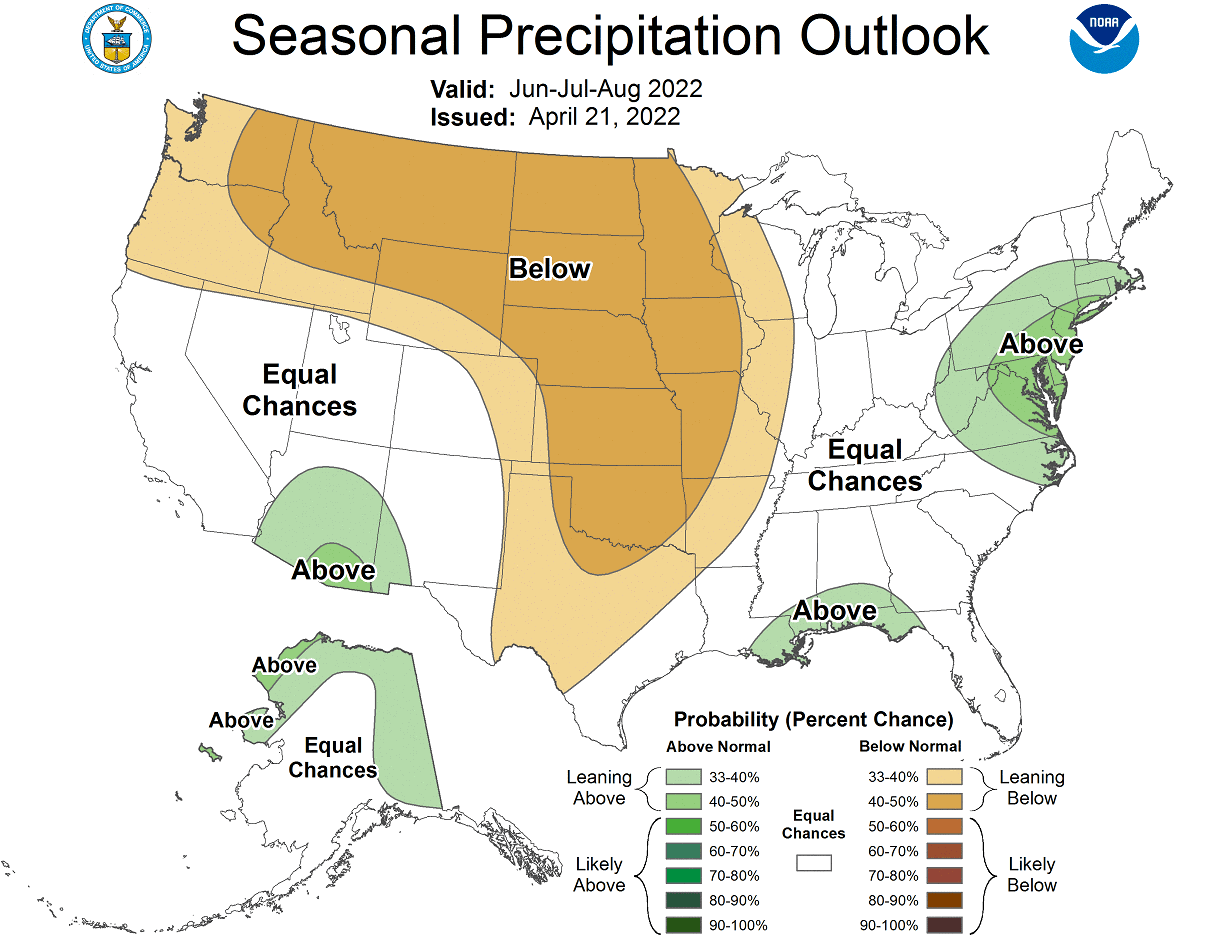
The problem with precipitation in any La Nina season is typically the persistence of drought conditions in the southern and western United States. Below we have the latest drought analysis from NOAA, which shows the current drought conditions across the country.

Most of the western half of the United States is under some level of drought conditions. The driest conditions prevail in the southern and northwestern United States. A hot and dry summer, as currently forecast for the south-central and northwestern states, will worsen the drought conditions.
ATLANTIC HURRICANE SEASON
We cannot go by the Atlantic hurricane season when talking about the La Nina. There is a well-known influence of the La Nina on the hurricane season, as we have different atmospheric conditions.
In the image below, you can see the tendency for more hurricanes in the Atlantic, as the vertical wind shear is lower and the atmosphere is more unstable. In contrast, there are fewer hurricanes in the eastern Pacific, due to stronger wind shear.
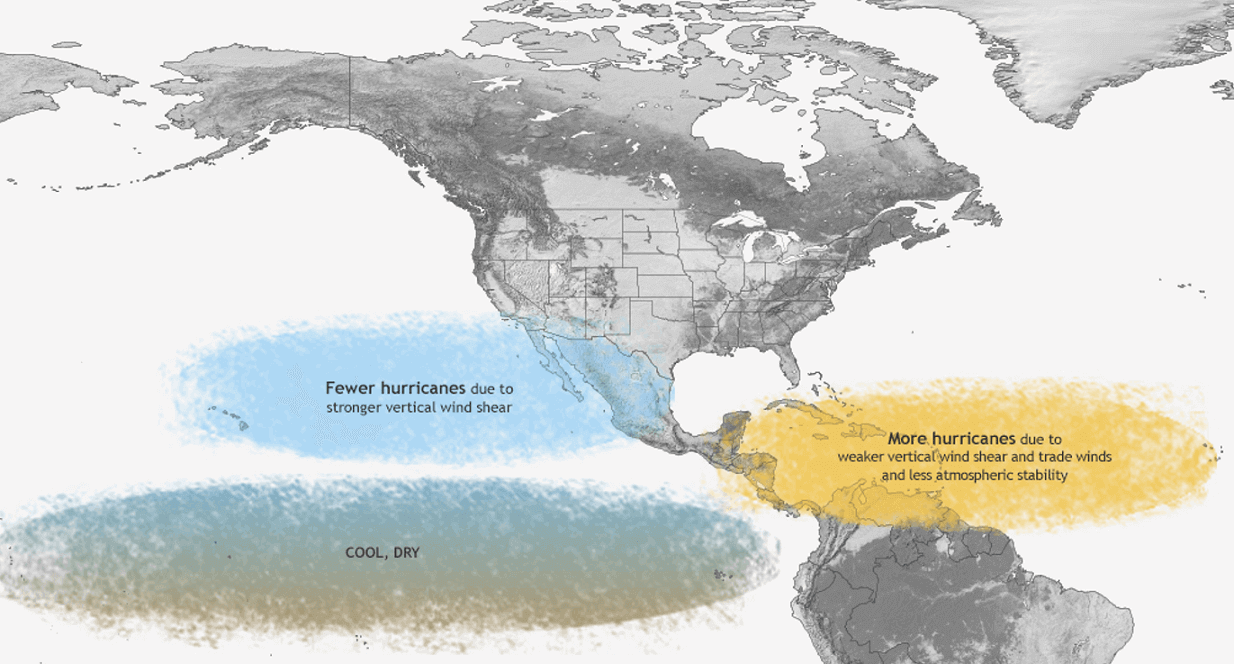
The latest ocean temperature forecast for the Hurricane season shows the active cold anomalies in the ENSO region. But in the tropical Atlantic Ocean, we see pretty neutral temperatures being forecast. A lack of warm anomalies in that region can indicate that a hyper-active season is currently less likely.
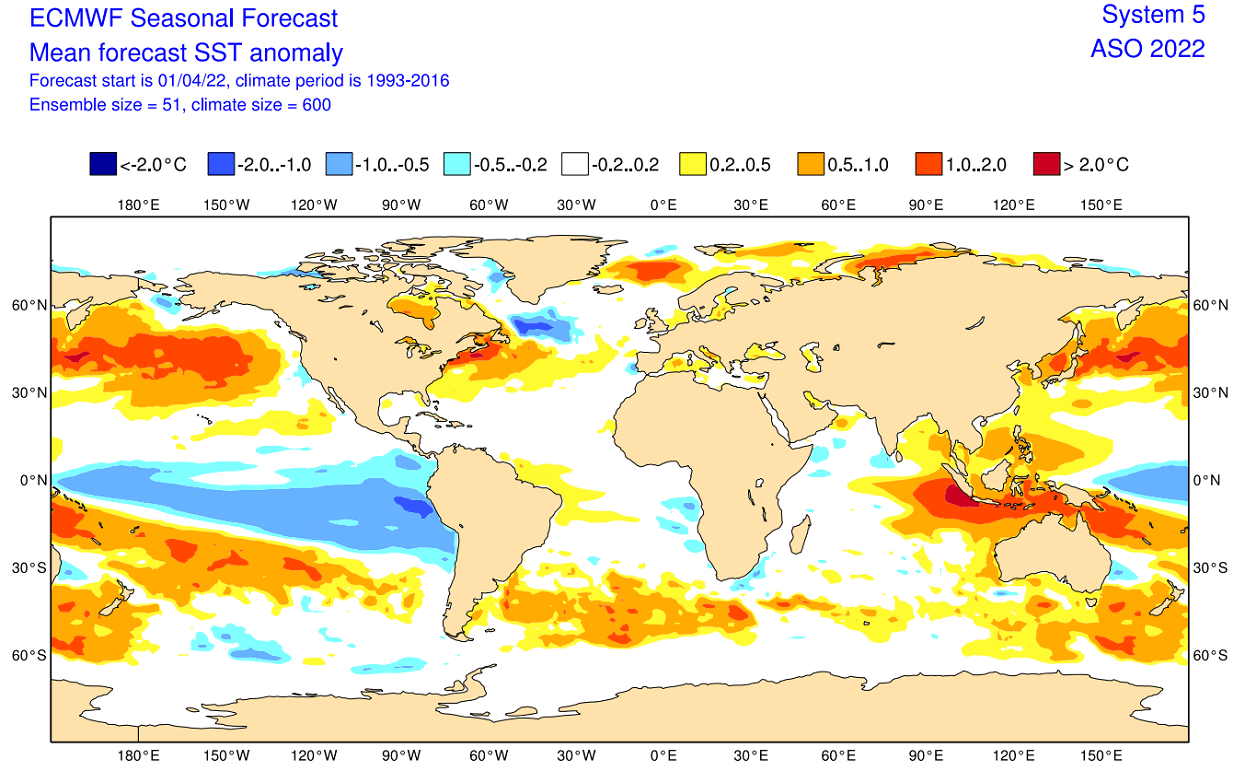
But looking at the actual ECMWF forecast for Accumulated Cyclone Energy (ACE), we do see an above-normal forecast for the Atlantic hurricane season. This can mean either a higher number of medium-power systems or a few major hurricanes that can quickly boost ACE.
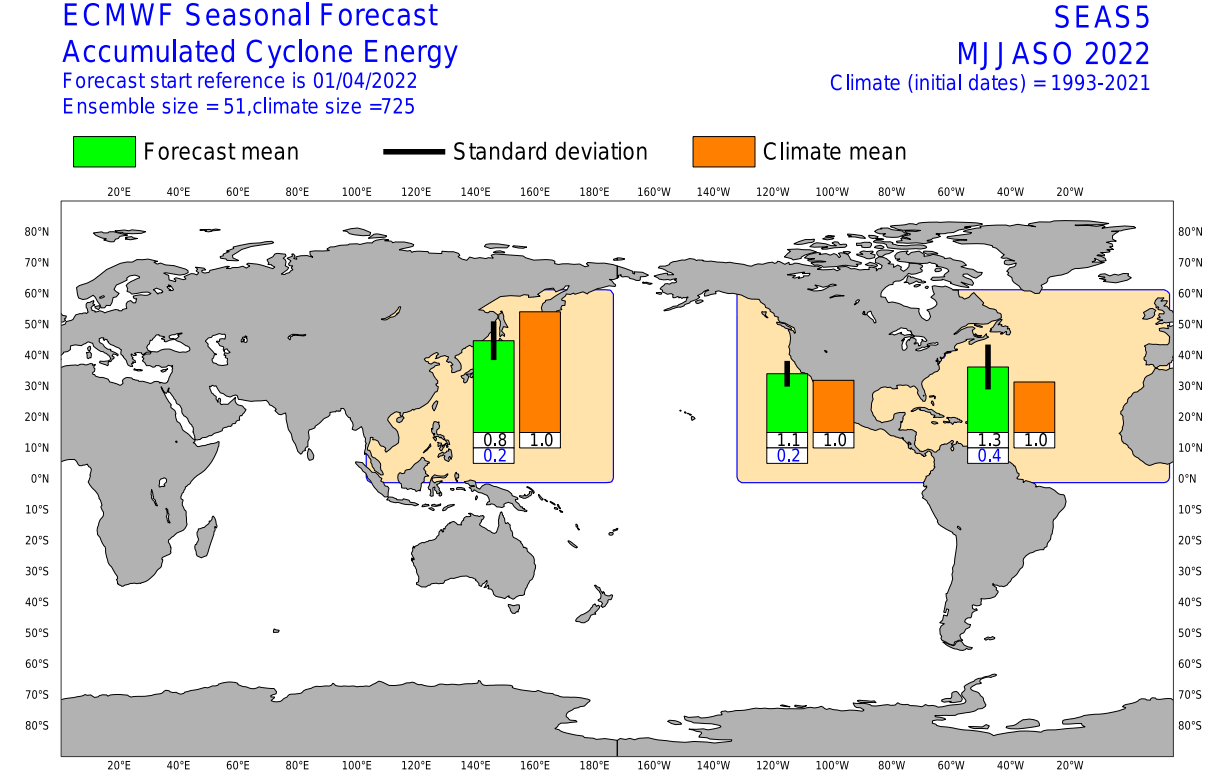
Accumulated cyclone energy (ACE) is generally a metric that expresses the energy of a tropical cyclone during its lifetime. We can combine the total energy from all systems to compare different seasons, which have been more active. But this does not mean much when it comes to landfalls.
A hurricane season with low total ACE can have 2-3 hurricane landfalls in the United States. On the other hand, a high-ACE season can have a higher number of storms that mainly stay out in the open waters.
We will keep you updated on the global weather development, so make sure to bookmark our page. Also, if you have seen this article in the Google App (Discover) feed, click the like (♥) button to see more of our forecasts and our latest articles on weather and nature in general.
SEE ALSO: